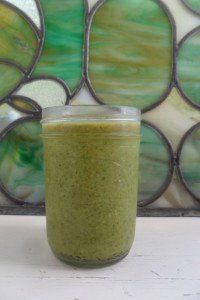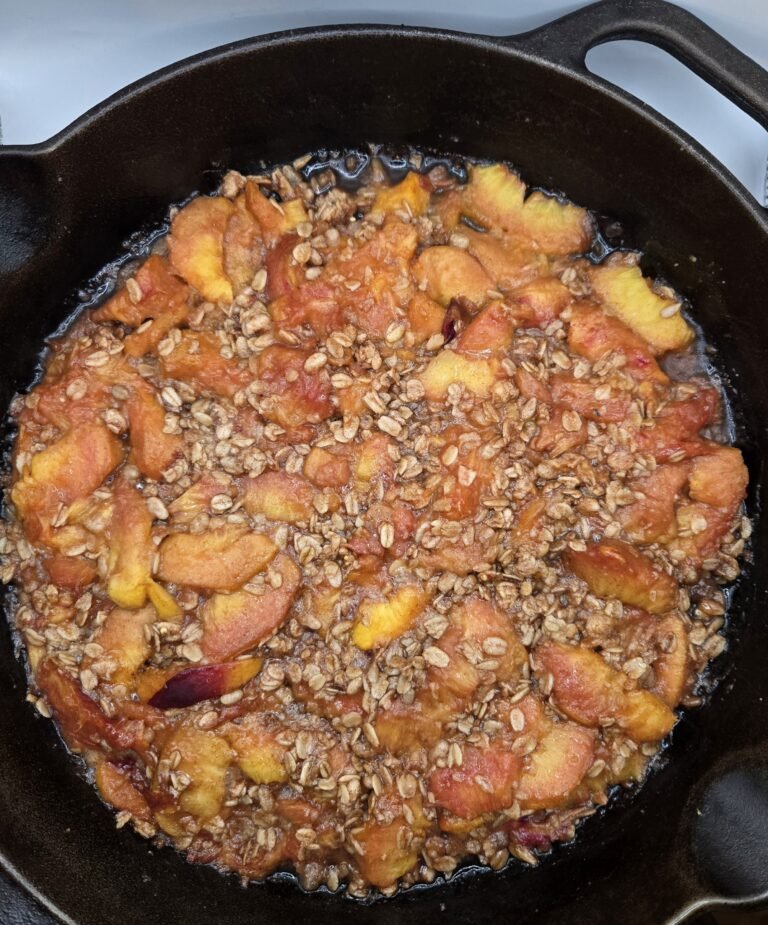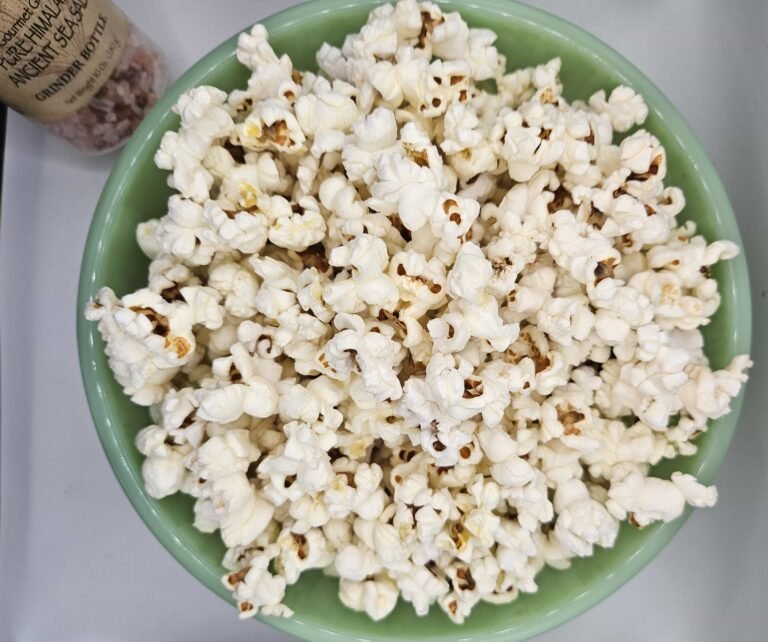The basil plants are large, healthy, and full of fragrant leaves. Basil likes moist soil and hot sun. A couple of plants will keep you with a steady supply of basil all summer, and you can certainly have an indoor plant for winter if you have room. If you want to freeze basil or pesto in the summer for use throughout winter, you’ll probably want a half dozen plants for a large supply of leaves. Continually pinch back the leaves as you need them, and even if you don’t so the plant will keep sprouting new leaves. You do not cut the woody stem until the plant is done for the season (you expect a frost).
 By now you know it’s getting easy to avoid refined white pasta. There are also a lot of great tasting choices for gluten-free, corn-free, non-GMO, organic whole wheat, or just about any kind of pasta you want. When mixing with pesto, before draining the pasta reserve a cup of the water to help thin out and disperse your pesto.How much pesto do you need for 1 lb of pasta? My preference depending on the type of pasta, is up to 2 cups. When using thicker, denser pasta, for example, fusilli or gnocchi, one cup of pesto might be enough. But thinner, stringier pasta takes more. Below I’m showing one pound of angel hair pasta first with a half cup of pesto mixed in, and again with a cup and a half – in addition to ¼ cup of olive oil and ½ cup of the pasta water. You can see that there isn’t yet enough pesto. There’s barely any liquid at the bottom either – it all combined with the pasta and pesto. At this point, it starts to become a matter of preference because some people may just want the pasta lightly coated with the pesto. Personally I like it saucier, and I would be happier with the two cups of pesto used with half of the one-pound box of angel hair. I’d like a small bed of pesto on the plate, mixed into the pasta, and surrounding the pasta a bit on the plate to eat with fresh garlic bread.
By now you know it’s getting easy to avoid refined white pasta. There are also a lot of great tasting choices for gluten-free, corn-free, non-GMO, organic whole wheat, or just about any kind of pasta you want. When mixing with pesto, before draining the pasta reserve a cup of the water to help thin out and disperse your pesto.How much pesto do you need for 1 lb of pasta? My preference depending on the type of pasta, is up to 2 cups. When using thicker, denser pasta, for example, fusilli or gnocchi, one cup of pesto might be enough. But thinner, stringier pasta takes more. Below I’m showing one pound of angel hair pasta first with a half cup of pesto mixed in, and again with a cup and a half – in addition to ¼ cup of olive oil and ½ cup of the pasta water. You can see that there isn’t yet enough pesto. There’s barely any liquid at the bottom either – it all combined with the pasta and pesto. At this point, it starts to become a matter of preference because some people may just want the pasta lightly coated with the pesto. Personally I like it saucier, and I would be happier with the two cups of pesto used with half of the one-pound box of angel hair. I’d like a small bed of pesto on the plate, mixed into the pasta, and surrounding the pasta a bit on the plate to eat with fresh garlic bread.
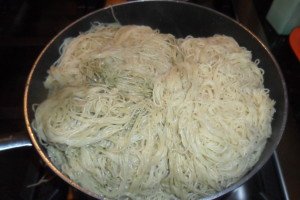
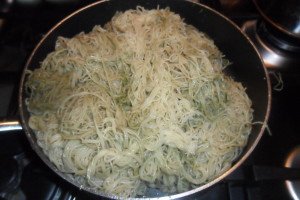
 By now you know it’s getting easy to avoid refined white pasta. There are also a lot of great tasting choices for gluten-free, corn-free, non-GMO, organic whole wheat, or just about any kind of pasta you want. When mixing with pesto, before draining the pasta reserve a cup of the water to help thin out and disperse your pesto.How much pesto do you need for 1 lb of pasta? My preference depending on the type of pasta, is up to 2 cups. When using thicker, denser pasta, for example, fusilli or gnocchi, one cup of pesto might be enough. But thinner, stringier pasta takes more. Below I’m showing one pound of angel hair pasta first with a half cup of pesto mixed in, and again with a cup and a half – in addition to ¼ cup of olive oil and ½ cup of the pasta water. You can see that there isn’t yet enough pesto. There’s barely any liquid at the bottom either – it all combined with the pasta and pesto. At this point, it starts to become a matter of preference because some people may just want the pasta lightly coated with the pesto. Personally I like it saucier, and I would be happier with the two cups of pesto used with half of the one-pound box of angel hair. I’d like a small bed of pesto on the plate, mixed into the pasta, and surrounding the pasta a bit on the plate to eat with fresh garlic bread.
By now you know it’s getting easy to avoid refined white pasta. There are also a lot of great tasting choices for gluten-free, corn-free, non-GMO, organic whole wheat, or just about any kind of pasta you want. When mixing with pesto, before draining the pasta reserve a cup of the water to help thin out and disperse your pesto.How much pesto do you need for 1 lb of pasta? My preference depending on the type of pasta, is up to 2 cups. When using thicker, denser pasta, for example, fusilli or gnocchi, one cup of pesto might be enough. But thinner, stringier pasta takes more. Below I’m showing one pound of angel hair pasta first with a half cup of pesto mixed in, and again with a cup and a half – in addition to ¼ cup of olive oil and ½ cup of the pasta water. You can see that there isn’t yet enough pesto. There’s barely any liquid at the bottom either – it all combined with the pasta and pesto. At this point, it starts to become a matter of preference because some people may just want the pasta lightly coated with the pesto. Personally I like it saucier, and I would be happier with the two cups of pesto used with half of the one-pound box of angel hair. I’d like a small bed of pesto on the plate, mixed into the pasta, and surrounding the pasta a bit on the plate to eat with fresh garlic bread.

If the pesto has been in the frig, it will thicken; mix it in a bowl with some of the pasta water and a little olive oil to thin it out to more of a sauce rather than a paste. Then it will be easier to toss with the pasta.
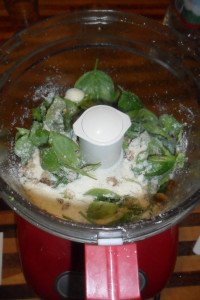
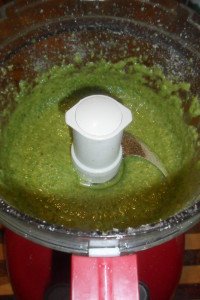
Basil Pesto
3 C fresh basil
¼ C pine nuts or walnuts
3 cloves garlic
½ C Parmesan cheese
1 t lemon juice
¾ C extra virgin olive oil
Put everything in the food processor except the oil. Turn it on and drizzle in the oil while it’s mixing. Use immediately or save in a jar for 1-2 weeks in the frig. Or, pour into an ice cube tray and, after the cubes freeze, put them in a zip bag. Keep in the freezer and have great, fresh pesto all winter.

